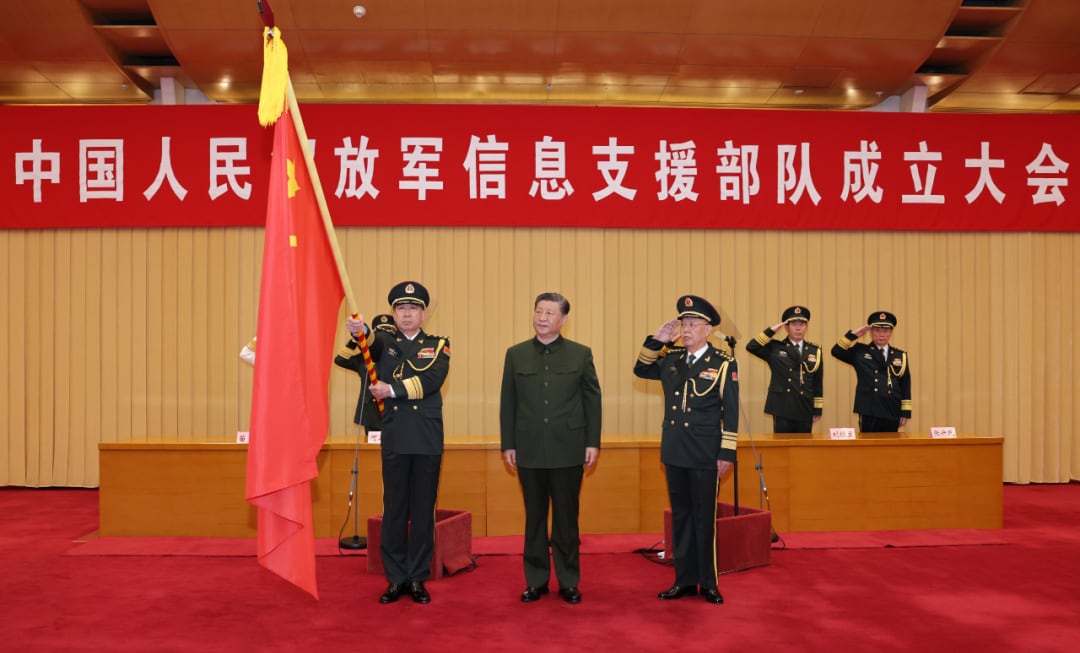CHRISTCHURCH, New Zealand — Chinese President Xi Jinping instigated a significant restructuring of the People’s Liberation Army on April 19 by axing the Strategic Support Force and replacing it with a new Information Support Force.
While it’s unclear exactly why Xi enacted this major reshuffle, analysts suspect both military capability and political control contributed to his decision.
Joel Wuthnow, a Chinese military expert with the Washington-based National Defense University, believes Xi wanted greater oversight of support forces with the People’s Liberation Army.
“PLA observations of the war in Ukraine have made very clear that an effective structure for support forces, including in the logistics and information domains, is essential for modern warfighting. My sense is that the SSF [Strategic Support Force] proved to be an unnecessary management layer that obscured Xi’s visibility into what the PLA was doing in space, cyberspace and other information disciplines,” Wuthnow told Defense News.
China created the SSF on Dec. 31, 2015. Its successor, the Information Support Force, will now handle network information systems and communications support, and possibly network defense.
The new organization operates alongside two other newly announced military arms — the Cyberspace Force and the Aerospace Force — plus the preexisting Joint Logistics Support Force. This leaves the PLA with a structure of four arms and four services, the latter comprising the Army, Navy, Air Force and Rocket Force.
The four arms are directly subordinate to the Central Military Commission, which is the top political party organ that oversees China’s armed forces. This means the commission’s leaders can directly deal with individual support forces rather than having to go through the SSF headquarters.
The latest move came as a surprise to observers, said Brendan Mulvaney, the director of the U.S. Air Force’s China Aerospace Studies Institute.
“Obviously it takes quite a bit of planning and groundwork to create a new force, much less disband another, but it appears the PLA kept these plans pretty well hidden from public view,” Mulvaney told Defense News.

Indeed, China is known for its lack of transparency. Gen. Ju Qiansheng, a former SSF commander, disappeared last year before reappearing briefly in February. Ju’s current status is unclear.
Mulvaney said corruption might have played a part in Xi’s decision. However, the SSF has not experienced corruption scandals at the level of the Rocket Force, whose leadership was detained by the authorities last year.
From an operational standpoint, the new structure is advantageous to China’s military, Wuthnow said, noting the SSF was as powerful as the PLA’s five theater commands, whereas the current four support forces are now one level lower. This means theater commanders can now more easily tap the support forces’ assets without the complication of dealing with higher headquarters.
“This should help break down silos in the PLA and improve the functioning of the joint operations systems,” Wuthnow said. The four support forces “are all functionally specialized and can focus on improving their trade without an unnecessary management layer.”
Overall, disruption to the PLA would “not be massive,” Mulvaney said.
“The new headquarters will take time to get up and running; stake out positions and roles; establish command and control as well as organizational relationships with the other services, forces and theater commands,” he explained. “But it won’t be as big of a shift as the 2015/2016 reforms, and really only affects a pretty small portion of the PLA as a whole.”
The Cyberspace and Aerospace forces will presumably continue as normal from their same locations. The Cyberspace Force succeeds the SSF’s former Network Systems Department, while the Aerospace Force supplants the Space Systems Department. In essence, these departments have been elevated, with their overarching SSF structure removed.
Senior Col. Wu Qian, a Defense Ministry spokesperson, described the Cyberspace Force’s mission as “reinforcing national cyber border defense, promptly detecting and countering network intrusions and maintaining national cyber sovereignty and information security.”
The force is also charged with carrying out offensive cyber operations. The U.S., the U.K. and New Zealand accused China last month of sponsoring malicious cyber activity.
Wu also said the Aerospace Force will “strengthen the capacity to safely enter, exit and openly use space.” Although China emphasizes the peaceful use of space, the Pentagon said in its latest annual report on China’s military that the PLA “views space superiority, the ability to control the space-enabled information sphere and to deny adversaries their own space-based information gathering and communication capabilities, as critical components to conduct modern ‘informatized warfare.’ ”
Xi has said the Information Support Force plays “a crucial role in advancing the Chinese military’s high-quality development and competitiveness in modern warfare.”
While the new structure means the four forces plug into the PLA’s joint operations system more easily because there are now fewer management layers, Mulvaney noted it’s likely a result of Xi wanting “more direct control of the information domain forces — and felt like the SSF wasn’t getting the job done.”
Gordon Arthur is an Asia correspondent for Defense News. After a 20-year stint working in Hong Kong, he now resides in New Zealand. He has attended military exercises and defense exhibitions in about 20 countries around the Asia-Pacific region.






